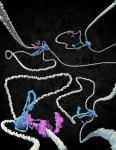(Press-News.org) PROVIDENCE, R.I. [Brown University] — With a new microscopy technique that uses blue light to measure electrons in semiconductors and other nanoscale materials, a team of Brown University researchers is opening a new realm of possibilities in the study of these critical components, which can help power devices like mobile phones and laptops.
The findings are a first in nanoscale imaging and provide a workaround to a longstanding problem that has greatly limited the study of key phenomena in a wide variety of materials that could one day lead to more energy-efficient semiconductors and electronics. The work published in Light: Science & Applications.
“There is a lot of interest these days in studying materials with nanoscale resolution using optics,” said Daniel Mittleman, a professor in Brown’s School of Engineering and author of the paper describing the work. “As the wavelength gets shorter, this becomes a lot harder to implement. As a result, nobody had ever done it with blue light until now.”
Typically, when researchers use optics like lasers to study nanoscale materials, they use light that emits long wavelengths such as red light or infrared. The method the researchers looked at in the study is called scattering-type scanning near-field microscopy (s-SNOM). It involves scattering light from a sharpened tip that is only a few tens of nanometers across. The tip hovers just above the sample material to be imaged. When that sample is illuminated with optical light, the light scatters and a portion of the scattered light is left with information about the nano-sized region of the sample directly beneath the tip. The researchers analyze that scattered radiation to extract information about this small volume of material.
The technique has been at the foundation of many technological advances, but it hits a wall when it comes to using light with a much shorter wavelength, like blue light. This means that using blue light, which is better suited for studying certain materials for which red light is ineffective, to gain new insights from already well-studied semiconductors has been out of reach since the 1990s when the technique was invented.
In the new study, the researchers from Brown present how they got around this roadblock to perform what’s believed to be the first ever experimental demonstration of s-SNOM using blue light instead of red.
For the experiment, the researchers used the blue light to get measurements from a silicon sample that cannot be obtained using red light. The measurements provided a valuable proof-of-concept about the use of shorter wavelengths to study materials on the nanoscale.
“We were able to compare these new measurements to what one might expect to see from silicon, and the match was very good,” Mittleman said. “It confirms that our measurement works and that we understand how to interpret the results. Now we can start studying all these materials in a way that we couldn't before.”
To conduct the experiment, the researchers had to get creative. Essentially, they decided to make things easier by making them more complicated. With the typical technique, for instance, blue light is hard to use because its wavelength is so short, meaning that it is more challenging to focus over the right spot near the metal tip. If not aligned just right, the measurement won’t work. With the red light, this focusing condition is more relaxed, making it easier to align the optics in order to extract the scattered light efficiently.
With those challenges in mind, the researchers used the blue light to not only illuminate the sample so that the light scatters, but also to produce a burst of terahertz radiation from the sample. The radiation carries important information about the sample’s electrical properties. While the solution adds an extra step and increases the amount of data the scientists have to analyze, it eliminates the need to be as precise in how they align the tip over the sample. The key here is that because the terahertz radiation has a much longer wavelength, it is much more easily aligned.
“It still has to be really close, but it doesn’t have to be as close,” Mittleman said. “When you hit it with the light, you’ll still be able to get information in the terahertz.”
The researchers are excited to see what comes next in terms of new information and discoveries the method leads to, such better insights into semiconductors used to produce blue LED technology. Mittleman is currently developing plans to use blue light to analyze materials researchers haven’t been able to before.
The work was led by Angela Pizzuto, a Brown physics Ph.D. student who will graduate in May. Pingchuan Ma, a Ph.D. student in Brown’s School of Engineering, also contributed.
The work was supported by the National Science Foundation Division of Electrical Communications and Cyber Systems, the Kansas City National Security Campus and the Department of Energy.
END
New blue light technique could enable advances in understanding nanoscale technologies
A team of Brown University researchers created a solution to a nanoscale resolution challenge that has for decades limited the study of materials that could lead to more energy efficient semiconductors and electronics
2023-04-19
ELSE PRESS RELEASES FROM THIS DATE:
Study finds that child victims of violence face long-term psychological effects
2023-04-19
A study of young adults who were victims of violent injuries as children found significantly higher levels of post-traumatic stress disorder (PTSD) in this group than the general population.
The study – conducted by University of Rochester Medical Center (URMC) researchers – surveyed 24 respondents who were victims of gunshot, stab, or assault wounds as children between the years of 2011 and 2020. Of the participants, 15 suffered a gunshot wound, eight suffered a stab wound, and one was assaulted. Respondents were primarily teenagers at the time of injury, with a median age of 16.6 years. An average of six years had passed from the initial injury to the time ...
Association for Chemoreception Sciences (AChemS) 45th Annual Meeting
2023-04-19
Bonita Springs, FL— Smell, taste, and chemesthesis are vital chemical senses that contribute to the multidimensional sensation of flavor. Together with other sensory inputs, they allow us to enjoy eating and drinking. Understanding the fundamental mechanisms underlying these sensations is a primary focus of the annual conference of the Association for the Chemoreception Sciences, AChemS XLV. Other key areas include factors that modulate these mechanisms and their impact on fundamental behavior in a wide array of species. Attendees and members of AChemS are leading scientific and biomedical researchers dedicated to better understanding the function ...
As pandemic prison populations fell, proportion of Black prisoners rose
2023-04-19
New Haven, Conn. — The U.S. prison population plummeted during the early months of the COVID-19 pandemic but the percentage of incarcerated Black people rose, according to a new analysis of prison data published April 19 in the journal Nature.
The higher percentage of incarcerated Black people by mid-2020 was found in almost all states, and temporarily reversed a decades-long decrease in the percentage of Black people in the national prison population, researchers from Yale and Northeastern Universities and the Santa Fe Institute found.
While several factors contributed to the increase in percentage of incarcerated Black people during the height of the pandemic, researchers ...
Cannabis exposures in suspected suicide attempts are on the rise
2023-04-19
VANCOUVER, Wash. – Suspected suicidal cannabis exposures have increased 17% annually, over a period of 12 years, according to a Washington State University-led analysis of U.S. poison center data.
The vast majority of the attempts, more than 92%, involved other substances in addition to cannabis, and the data cannot show a direct causal link between cannabis and suicide attempts. Still, the findings are cause for concern, the researchers said, especially since the increase was more pronounced among children and women ...
Mind-body connection is built into brain, study suggests
2023-04-19
Calm body, calm mind, say the practitioners of mindfulness. A new study by researchers at Washington University School of Medicine in St. Louis indicates that the idea that the body and mind are inextricably intertwined is more than just an abstraction. The study shows that parts of the brain area that control movement are plugged into networks involved in thinking and planning, and in control of involuntary bodily functions such as blood pressure and heartbeat. The findings represent a literal linkage of body and mind ...
Race, ethnicity–adjusted age recommendation for initiating breast cancer screening
2023-04-19
About The Study: This study of 415,000 breast cancer deaths in female patients in the U.S. from 2011 to 2020 provides evidence-based race-adapted starting ages for breast cancer screening. The findings suggest that health policy makers and clinicians could consider an alternative, race and ethnicity–adapted approach in which Black female patients start screening earlier.
Authors: Mahdi Fallah, M.D., Ph.D., of the German Cancer Research Center in Heidelberg, Germany, and Tianhui Chen, M.D., Ph.D., of the Zhejiang Cancer Hospital in Hangzhou, China, are the corresponding authors.
To access the embargoed study: ...
Cognitive function in people with familial risk of depression
2023-04-19
About The Study: Depression in prior generations was associated with lower cognitive performance in offspring, whether assessed by family history or genetic data. There are opportunities to generate hypotheses about how this arises through genetic and environmental determinants, moderators of brain development and brain aging, and potentially modifiable social and lifestyle factors across the life span.
Authors: Breda Cullen, Ph.D., of the University of Glasgow in Glasgow, United Kingdom, is the corresponding author.
To ...
Nature publication on loops, flags and tension in DNA
2023-04-19
1 Cohesin loops DNA
It has been known for more than a century that the long DNA strands in cell nuclei are neatly folded into the characteristic shape of chromosomes, resembling bottlebrushes , in preparation for cell division. And also between divisions, chromosomes are organised into loops that are important for regulating the processing genetic information. In 2018, Dekker and his group were the first to visualise how SMC protein complexes such as condensin and cohesin extrude loops in DNA.
#2 CTCF flags have a direction and determine where a ...
Nature-study reveals new mechanism for DNA folding
2023-04-19
A hitherto unknown mechanism for DNA folding is described in a study in Nature published by researchers from Karolinska Institutet and the Max Planck Institute for Biophysics. Their findings provide new insights into chromosomal processes that are vital to both normal development and to prevent disease.
The DNA in our cells is organised into chromosomes, which are highly dynamic structures that are altered when genes are transcribed, when DNA damage is repaired or when chromosomes are compacte in preparation for cell division. These processes are affected by so called SMC protein complexes (SMC, Structural Maintenance of Chromosomes), which by mediating chromosomal interactions ...
New findings pave the way for stable organic solar cells that may enable cheap and renewable electricity generation
2023-04-19
Due to the recent improvements in the efficiency with which solar cells made from organic (carbon-based) semiconductors can convert sunlight into electricity, improving the long-term stability of these photovoltaic devices is becoming an increasingly important topic. Real-world applications of the technology demand that the efficiency of the photovoltaic device be maintained for many years. To address this key problem, researchers have studied the degradation mechanisms for the two components used in the light-absorbing layer of organic solar cells: the ‘electron donor’ and ‘electron ...
LAST 30 PRESS RELEASES:
New expert guidance urges caution before surgery for patients with treatment-resistant constipation
Solar hydrogen can now be produced efficiently without the scarce metal platinum
Sleeping in on weekends may help boost teens’ mental health
Study: Teens use cellphones for an hour a day at school
After more than two years of war, Palestinian children are hungry, denied education and “like the living dead”
The untold story of life with Prader-Willi syndrome - according to the siblings who live it
How the parasite that ‘gave up sex’ found more hosts – and why its victory won’t last
When is it time to jump? The boiling frog problem of AI use in physics education
Twitter data reveals partisan divide in understanding why pollen season's getting worse
AI is quick but risky for updating old software
Revolutionizing biosecurity: new multi-omics framework to transform invasive species management
From ancient herb to modern medicine: new review unveils the multi-targeted healing potential of Borago officinalis
Building a global scientific community: Biological Diversity Journal announces dual recruitment of Editorial Board and Youth Editorial Board members
Microbes that break down antibiotics help protect ecosystems under drug pollution
Smart biochar that remembers pollutants offers a new way to clean water and recycle biomass
Rice genes matter more than domestication in shaping plant microbiomes
Ticking time bomb: Some farmers report as many as 70 tick encounters over a 6-month period
Turning garden and crop waste into plastics
Scientists discover ‘platypus galaxies’ in the early universe
Seeing thyroid cancer in a new light: when AI meets label-free imaging in the operating room
Neutrophil-to-lymphocyte ratio may aid risk stratification in depressive disorder
2026 Seismological Society of America Annual Meeting
AI-powered ECG analysis offers promising path for early detection of chronic obstructive pulmonary disease, says Mount Sinai researchers
GIMM uncovers flaws in lab-grown heart cells and paves the way for improved treatments
Cracking the evolutionary code of sleep
Medications could help the aging brain cope with surgery, memory impairment
Back pain linked to worse sleep years later in men over 65, according to study
CDC urges ‘shared decision-making’ on some childhood vaccines; many unclear about what that means
New research finds that an ‘equal treatment’ approach to economic opportunity advertising can backfire
Researchers create shape-shifting, self-navigating microparticles
[Press-News.org] New blue light technique could enable advances in understanding nanoscale technologiesA team of Brown University researchers created a solution to a nanoscale resolution challenge that has for decades limited the study of materials that could lead to more energy efficient semiconductors and electronics



